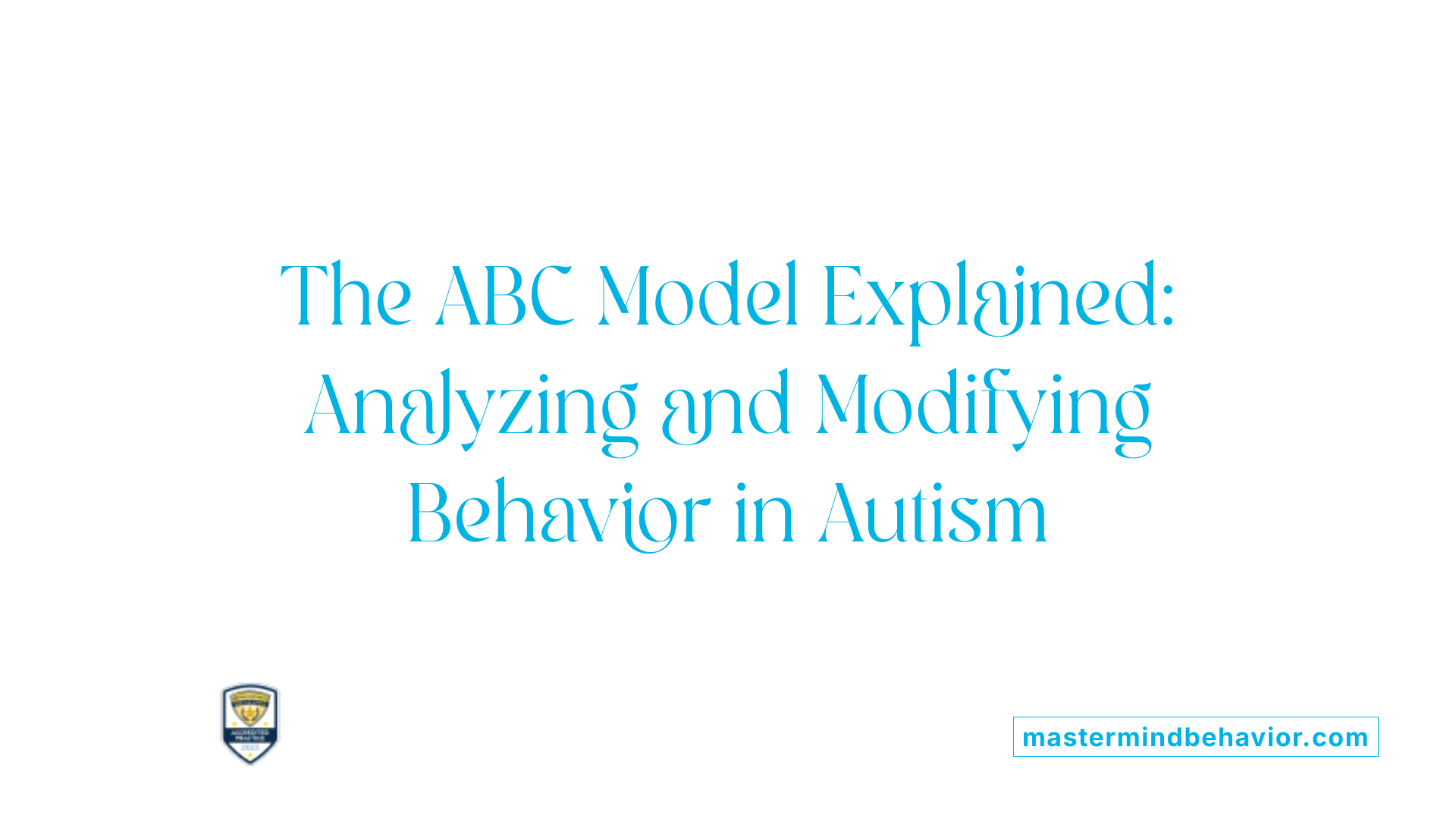Understanding Functional Communication Training (FCT) In ABA Therapy

Bridging Behavior and Communication in Autism Support
Functional Communication Training (FCT) is a cornerstone intervention within Applied Behavioral Analysis (ABA) therapy designed specifically to empower individuals with autism spectrum disorder (ASD) and other developmental disabilities to communicate effectively. By replacing challenging behaviors with purposeful communication strategies, FCT not only addresses immediate behavioral concerns but also facilitates long-term improvements in social skills, independence, and quality of life. This article explores the foundational principles of ABA therapy, the vital role of FCT, its implementation methods, and the broad benefits witnessed through this evidence-based approach.
The Foundations of ABA Therapy and Its Role in Autism Support

What is Applied Behavioral Analysis (ABA) therapy and how does it help individuals with autism?
Applied Behavioral Analysis (ABA) therapy is an evidence-based treatment that applies learning principles to help individuals with autism develop essential skills and address challenging behaviors. It focuses on using positive reinforcement to encourage desired behaviors, promoting skill acquisition in communication, social interactions, self-care, academics, and daily living.
ABA therapy uses the A-B-C model—Antecedent, Behavior, Consequence—to analyze and modify behavior. The antecedent is what happens before a behavior, the behavior is the individual's action, and the consequence follows the behavior and influences its future occurrence. This approach helps therapists understand why behaviors happen and how to promote more positive behaviors.
ABA programs are personalized through comprehensive assessments tailored to each individual's needs. Early intervention is especially beneficial, often leading to improved language skills, better social engagement, increased independence, and reduced problem behaviors. Overall, ABA therapy aims to improve the quality of life by equipping individuals with meaningful, functional skills to navigate their environment effectively.
Qualified Professionals Delivering ABA and FCT

Who Typically Provides ABA Therapy for Autism and What Qualifications Do They Have?
ABA therapy for children with autism is commonly provided by highly qualified professionals known as Board Certified Behavior Analysts (BCBAs). These individuals typically hold advanced degrees in fields like psychology, education, or behavior analysis and have specialized training in behavioral science. Their expertise enables them to design, implement, and supervise tailored treatment programs that address each child's unique needs.
Roles and Credentials of Registered Behavior Technicians (RBTs)
Registered Behavior Technicians (RBTs) carry out the day-to-day delivery of ABA therapy under the close supervision of BCBAs. They are trained to implement behavior intervention plans effectively, ensuring consistent and accurate application of strategies such as Functional Communication Training (FCT). Though pivotal in therapy delivery, RBTs work strictly under the guidance of BCBAs and are not independent practitioners.
Importance of Evidence-Based Practices and Professional Supervision
Maintaining strict adherence to evidence-based practices is essential in ABA and FCT therapies. BCBAs are responsible for ongoing assessment and data-driven decisions, ensuring interventions are scientifically supported and ethical. Regular supervision of RBTs by BCBAs guarantees fidelity to treatment protocols and quickly addresses any concerns, maximizing treatment effectiveness.
Experience and Training Standards for ABA Providers
Most Board Certified Behavior Analysts have extensive experience, often spanning over a decade, managing adolescents and young adults with autism spectrum disorder. Providers are required to maintain licensure and professional certification that emphasizes continual education and compliance with the latest research and ethical standards.
This robust framework of qualifications, roles, training, and supervision ensures that ABA therapy and FCT are delivered safely, effectively, and compassionately to support meaningful progress in children with autism.
Functional Communication Training: Principles and Implementation

What is Functional Communication Training (FCT) and its goals within ABA therapy?
Functional Communication Training (FCT) is a targeted intervention used within Applied Behavior Analysis (ABA) therapy to help children with autism and developmental disabilities develop meaningful communication skills. The main goal of FCT is to replace challenging behaviors that arise from communication difficulties with socially acceptable methods of interaction, such as gestures, sign language, or picture exchange systems like PECS. By teaching effective communication, FCT reduces behaviors like aggression, tantrums, or self-injury that often occur due to frustration or inability to express needs.
How does FCT identify and replace problem behaviors with communication?
FCT starts by determining why an individual is engaging in problem behavior through a systematic functional behavioral assessment (FBA). This assessment identifies the function of the behavior—such as seeking attention, escaping demands, or accessing materials. Once the function is understood, FCT teaches an appropriate communicative response that serves the same purpose but in a socially acceptable way. For example, instead of hitting to gain attention, a child might learn to use a gesture or vocal request.
What is the role of the Functional Behavioral Assessment (FBA) in FCT?
The FBA is critical in guiding FCT by revealing the maintaining reinforcers of problem behaviors. This insight allows practitioners to select communication methods that effectively serve the function of the original behavior. Without this step, teaching communication that does not address the behavior’s purpose may be ineffective.
What communication methods are commonly taught in FCT?
FCT uses a variety of communication means tailored to the individual's needs and abilities, including:
- Vocal requests or verbalizations
- Manual signs or sign language
- Picture exchange systems (PECS)
- Use of assistive technology or voice output devices
Selection depends on factors such as ease of learning, recognizability by others, and the person's existing language skills.
How is FCT implemented stepwise with prompting, reinforcement, and fading?
FCT interventions are conducted in stages:
- Begin with controlled teaching environments and use prompting strategies (such as least-to-most or most-to-least prompts) to facilitate learning the new communication behavior.
- Use continuous positive reinforcement to encourage the alternative communication and withhold reinforcement for the problem behavior (extinction).
- Gradually fade prompts and reduce reinforcement schedules to more naturalistic levels to promote independence.
What extinction and reinforcement strategies are used in FCT?
Extinction involves withholding the reinforcement that previously maintained the problem behavior while reinforcing the communicative replacement. This dual approach effectively decreases unwanted behavior while strengthening desired communication.
How does FCT promote generalization across settings and caregivers?
To ensure communication skills transfer beyond training sessions, FCT employs strategies such as:
- Involving multiple trainers and caregivers
- Using similar stimuli across teaching environments
- Sequential training in various natural settings (e.g., home, school)
These approaches help the individual use functional communication reliably in everyday life situations.
Techniques and Behavioral Strategies in ABA and FCT
What are some common techniques used in ABA therapy for behavioral improvement?
ABA therapy employs a variety of techniques aimed at enhancing communication, social skills, and reducing challenging behaviors through structured and individualized methods.
Positive reinforcement is fundamental, where desirable behaviors are immediately rewarded to encourage their recurrence. This principle also extends to differential reinforcement, where specific acceptable behaviors are reinforced while undesirable ones are ignored or not reinforced.
Prompting and fading are key strategies used to teach new skills. Practitioners use least-to-most prompting—starting with minimal assistance and increasing support as needed—or most-to-least prompting, providing maximum help initially and gradually reducing it to promote independence.
Discrete Trial Training (DTT) breaks down complex skills into manageable, repeatable steps, providing clear stimuli and consequences, which improves learning efficiency. Behavior chaining complements this by linking individual simple steps into a complex behavior sequence. Visual modeling, such as using pictures or videos, supports learners through imitation and comprehension.
Behavioral assessment is crucial for tailoring treatment. It involves continuous data collection and analysis to monitor progress and adjust interventions. Functional Behavioral Assessments (FBAs) identify the purpose of challenging behaviors, guiding the selection of appropriate communication responses in FCT.
Extinction is often used alongside reinforcement, whereby the reinforcement maintaining problematic behaviors is withheld, encouraging learners to adopt functional communication.
Reinforcement schedules evolve from continuous reinforcement during initial teaching phases to systematically thinned, intermittent schedules that better resemble natural environments. This transition helps maintain behaviors while fostering independence. However, thinning can sometimes cause behavior reemergence; in such cases, strategies like reintroducing reinforcement, using competing stimuli, or applying mild punishment may be necessary.
Teaching opportunities in FCT and ABA vary—they may be contrived (structured scenarios) or natural (real-life contexts). Both have advantages: contrived settings allow focused skill acquisition, while natural settings promote generalization.
Overall, these integrated behavioral techniques support the replacement of problematic behaviors with functional communication and adaptive skills, improving quality of life for individuals with autism and developmental disorders.
Outcomes, Benefits, and Evidence Supporting FCT in ABA Therapy
How is the effectiveness of ABA therapy measured in individuals with autism?
The effectiveness of ABA therapy, including Functional Communication Training (FCT), is measured using systematic data collection focused on specific behavioral goals. Practitioners define behaviors clearly and collect quantifiable data on their frequency, duration, or quality. Progress monitoring involves graphing these behaviors over time to visualize improvements and trends. Experimental designs like ABAB or alternating treatments help isolate the impact of the interventions objectively. This rigorous measurement ensures a data-driven approach to assessing progress and guides instructional adjustments.
Behavioral improvements including reduced aggression, tantrums, and self-injury
FCT effectively reduces problem behaviors such as aggression, tantrums, self-injury, and other challenging behaviors commonly experienced by individuals with autism. By teaching socially acceptable communication methods that serve the same function as the difficult behaviors, children learn to express needs without frustration or harm. This behavioral improvement enhances safety and daily functioning for both the individual and caregivers.
Communication skill development and social benefits
Beyond reducing problem behaviors, FCT promotes meaningful communication skills. Methods like sign language, picture exchange, or vocalizations empower children to request attention, escape demands, or gain access to preferred items. This communication development often leads to enhanced social skills, improved play, and better readiness for school environments. Use of FCT supports stronger relationships and increased independence.
Research-based evidence from meta-analyses and autism treatment authorities
Extensive research supports FCT as an evidence-based practice for individuals with autism. Meta-analyses and systematic reviews report large effect sizes for reduction in challenging behaviors and increases in communication skills. Agencies including the National Autism Center and the National Clearinghouse on Autism Evidence and Practice endorse FCT, highlighting its strong empirical foundation and success in natural settings.
Long-term improvements in independence and quality of life
When implemented correctly and generalized across settings and caregivers, FCT leads to long-term gains in independence and overall quality of life. Children transition from frustration-driven behaviors to constructive communication, facilitating smoother interactions and reduced need for intensive supports.
Low cost and integration within broader autism intervention frameworks
FCT is a cost-effective intervention readily integrated within Applied Behavior Analysis (ABA) therapy programs. Its flexibility allows it to be part of comprehensive autism interventions such as Autism Focused Intervention Resources & Modules (AFIRM), maximizing benefits while being accessible for families and professionals.
Resources supporting structured implementation and caregiver involvement
Structured resources accompany FCT implementation, including planning checklists, step-by-step guides, and progress monitoring tools. These resources foster consistent application and facilitate caregiver and professional collaboration, which is crucial to the success and generalization of communication skills across environments.
Advancing Communication Through Evidence-Based Training
Functional Communication Training is a transformative component of ABA therapy that addresses the core challenge of communication difficulties in individuals with autism and developmental disabilities. Supported by extensive research and ethical clinical practices, FCT replaces disruptive behaviors with meaningful, socially acceptable communication tailored to each individual’s unique needs. Delivered by highly qualified professionals, it integrates systematic assessment, specialized teaching methods, and ongoing reinforcement to facilitate lasting behavioral improvements. By enhancing communication skills, FCT not only reduces problem behaviors but also promotes greater independence, social interaction, and overall quality of life—underscoring its vital role in effective autism interventions.
References
- What is Functional Communication Training?
- Functional Communication Training: A Review and ...
- Functional Communication Training (FCT) in ABA Therapy
- Functional Communication Training (FCT)
- Bridging the Gap: Functional Communication in ABA
- Functional Communication Training Brief Packet - AFIRM
- ASD Intervention Effectiveness: How Do We Measure ...
- The effectiveness of applied behavior analytic interventions ...
Recent articles

Teaching Coping Skills For Test Anxiety Through ABA Therapy
Harnessing ABA Therapy to Equip Children with Autism Against Test Anxiety

ABA Therapy For Supporting Flexibility In Changing Schedules
Navigating Change: ABA Therapy as a Lifeline for Flexible Routines

How ABA Therapy Improves Coping During Times Of Transition
Navigating Change with Confidence: The Role of ABA Therapy

How ABA Therapy Improves Morning And Bedtime Routines
Transforming Daily Habits: The Role of ABA Therapy in Structured Routines for Autism

How ABA Therapy Improves Coping With Unstructured Free Time
Enhancing Daily Living: ABA Therapy and Managing Unstructured Time for Children with Autism

How ABA Therapy Supports Children During Community Events
Supporting Autism Spectrum Children Through Applied Behavior Analysis in Social Settings



